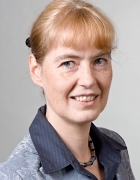
Prof. Dr. Katharina Krischer
Academic Career and Research Areas
The research activities of Prof. Krischer cover self-organization in physical and physicochemical systems as well as electrocatalysis. She focuses in particular on efficient photoelectrochemical and electrocatalytic energy conversion and universal mechanisms of structure formation processes in nonequilibrium systems.
After studying at Freie Universität Berlin and Munich’s Ludwig Maximilian University, Prof. Krischer was a research associate at the Fritz Haber Institute in Berlin (Prof. Ertl). After completing her doctorate, she did postdoctoral research for one year at Princeton University, USA. She then returned to the Fritz Haber Institute to do her lecturer qualification. Since 2002, she has been professor of technical physics at TUM. Prof. Krischer is a Fellow (Class of 2018) of the International Society of Electrochemistry (ISE). During 2023-2024 she served as President of the ISE; she served as President Elect in 2021-2022, and serves as immediate Past President (2025-2026). Since 2021 she has been a member of the Scientific Advisory Board of the Weierstrass Institute for Applied Analysis and Stochastics, Berlin, and serves on the Editorial Advisory Boards of Chaos (AIP Publishing) and the Journal of Electroanalytical Chemistry (Elsevier). She is Deputy Equal Opportunities Officer of the TUM School of Natural Sciences.
Awards
- deGruyter Award of the Berlin-Brandenburg Academy of Sciences and Humanities (1998)
- ADUC Annual Award for Habilitation Students (1996)
- Otto Hahn Medal of the Max Planck Society (1991)
- Scholarship of the German National Academic Foundation (1983)
Key Publications (all publications)
Maier TL, de Kam LBT, Golibrzuch M, Angerer T, Becherer M, and Krischer K: „How Metal/Insulator Interfaces Enable an Enhancement of the Hydrogen Evolution Reaction Kinetics”. ChemElectroChem. 2024; 11: e20240010.
AbstractBerger LM, Duportal M, de Souza Menezes L, Cortés E, Maier SA, Tittl A, and K. Krischer K: „Improved in-situ characterization of electrochemical interfaces using metasurface-driven surface-enhanced infrared absorption spectroscopy”. Adv. Functional Materials. 2023; 33: 2300422.
AbstractHaugland SW, Tosolini A, and Krischer K: „Between synchrony and turbulence: Intricate hierarchies of coexistence patterns”. Nature Comm. 2021; 12:5634.
AbstractPatzauer M and Krischer K: „Self-organized multifrequency clusters in an oscillating electrochemical system with strong nonlinear coupling”. Phys. Rev. Lett. 2021; 126, 194101.
AbstractKemeth F, Haugland SW, and Krischer K: „Symmetries of chimera states”. Phys. Rev. Lett. 2018; 120, 214101.
AbstractIf you wish your profile to be changed or updated please contact Franz Langer.